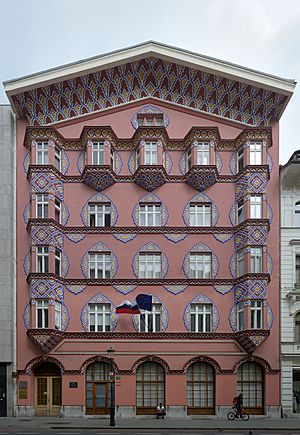Ivan Vurnik facts for kids
Quick facts for kids
Ivan Vurnik
|
|
|---|---|
| Born | 1 June 1884 Ljubljana, Duchy of Carniola, Austria-Hungary
|
| Died | 8 April 1971 (aged 86) Ljubljana, SR Slovenia, SFR Yugoslavia
|
| Alma mater | Vienna University of Technology |
| Occupation | Architect |
| Buildings | Cooperative Business Bank |
Ivan Vurnik (born June 1, 1884 – died April 8, 1971) was a famous Slovene architect. He helped start the important Ljubljana School of Architecture. In the 1920s, Vurnik looked for a special "Slovene National Style" in his buildings. This style was inspired by traditional Slovene art and a fancy art style called Art Nouveau from Vienna.
Later, in the 1930s, he started designing buildings that were more about being useful and practical. This style is known as functionalism. Vurnik's new ideas were different from the more traditional approach of another famous architect, Jože Plečnik. The Cooperative Business Bank in Ljubljana is one of Vurnik's most famous works. He designed it with his wife, Helena Kottler Vurnik, who created the colorful front of the building using the colors of the Slovene flag. Many people call it the most beautiful building in Ljubljana. Vurnik also drew many plans for cities, including Bled (1930), Kranj (1933–1937), and Ljubljana (1935).
Contents
Ivan Vurnik's Early Life
Ivan Vurnik was born on June 1, 1884, in a town called Radovljica in what was then the Austro-Hungarian Empire, now Slovenia. His father was a stonemason, which means he worked with stone. Because his family was well-off, Ivan was able to go to school. He first studied in Kranj and then in Ljubljana.
Studying Architecture in Vienna
In 1907, Vurnik went to the Vienna University of Technology to study architecture. He was a very good student and graduated with top honors in 1912. In Vienna, he was inspired by the Art Nouveau style, especially by the work of another Slovene architect, Max Fabiani. Vurnik and Fabiani remained friends throughout their lives.
After graduating, Vurnik received a scholarship. This allowed him to travel to Italy to study Italian architecture. In 1913, he married a talented artist from Vienna named Helena Vurnik, whose maiden name was Kotler.
World War I and Moving to Ljubljana
During World War I, Vurnik served as an Austrian soldier. He worked on designing military graveyards in Serbia in 1917 and 1918. After the war, in 1919, he and his wife moved to Ljubljana, Slovenia.
Ivan Vurnik's Architectural Work
In October 1912, Vurnik started working for architect Ludwig Baumann. That same year, he renovated the inside of a church in Bled. From 1913 to 1915, he also worked on a chapel in Trieste.
Searching for a Slovene Style
After World War I, Vurnik began to search for a unique "Slovene National Style" in his architecture. He wanted his buildings to reflect Slovene culture and art. The best example of this style is the Cooperative Business Bank from 1921. Vurnik designed the building, but his wife, Helena Vurnik, created the beautiful, colorful decorations on the outside. These decorations used the "national colors" of the Slovene flag. This building is still considered one of the most beautiful in Ljubljana.
Moving Towards Functionalism
In the late 1920s, Vurnik changed his style. He started to focus on functionalist architecture, which means designing buildings that are mainly useful and practical. He designed the main building for the Slovenian Sokol movement, called Sokol Hall or Tabor Hall, in Ljubljana. He also designed two similar buildings, one in Golnik and another in Kranj (which was destroyed during World War II). At this point, he stopped trying to find a "National Style."
Teaching and Later Projects
In 1919, Vurnik helped create an architecture department at the University of Ljubljana. He invited the famous Slovene architect Jože Plečnik to be one of the first teachers there.
However, Vurnik and Plečnik had different ideas about architecture. Vurnik believed that Plečnik's traditional views stopped his own more functionalist projects from being built. They also had different political ideas. Plečnik was more traditional and religious, while Vurnik was more progressive.
After 1925, Vurnik spent most of his time teaching. He continued to draw many architectural and city planning projects, but most of them were never built. Some of his most famous projects from this later period include the summer swimming pool in Radovljica and the Grajski dvor hotel in the same town. He also designed simple, useful family houses for factory workers in Maribor. These houses showed his new, practical style.
In 1965, Vurnik renovated a national Catholic shrine in Brezje. This project saw him briefly return to the "National Style" he had explored earlier in his career.
Awards and Recognition
- In 1961, Ivan Vurnik received the Pechtl Award in Vienna.
- In 1966, he was awarded the Prešeren Award in Ljubljana, which is one of Slovenia's highest honors for artists.
In Media
In 2013, the Slovenian National TV (RTV Slovenija) made a film about the life story of Ivan Vurnik and his wife, Helena. The film was directed by Alma Lapajne.
See also
 In Spanish: Ivan Vurnik para niños
In Spanish: Ivan Vurnik para niños


